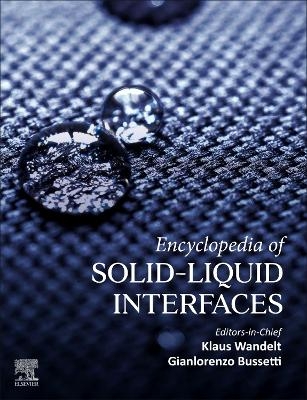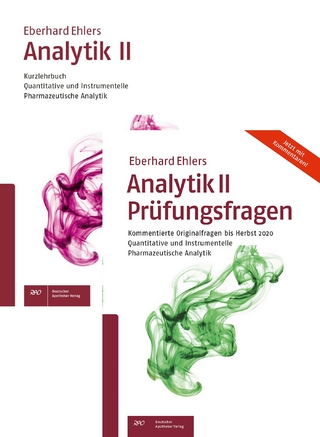
Encyclopedia of Solid-Liquid Interfaces
Elsevier - Health Sciences Division
978-0-323-85669-0 (ISBN)
Covering an area of chemistry that plays a fundamental role in nature and technology, the book compiles all relevant features of the field into a ‘one-stop’ reference source that will be relevant to a wide range of interdisciplinary scientists, researchers and academics. Encompassing 155 chapters by renowned experts, and led by leading names in the field, the contents will be organized over 3 volumes.
Klaus Wandelt received his PhD in Physical Chemistry at the Ludwig-Maximilians-University (LMU) in München in 1975, he spent a postdoctoral period at the IBM Research Laboratory in San Jose, California, in 1976 and 1977, and qualified as a professor by his Habilitation at the LMU, München, in 1981. After his first appointment as professor in physics at the LMU in 1983, he moved to the Fritz-Haber-Institute of the Max-Planck-Society (FHI) in Berlin in 1986 and also became professor of Physical Chemistry at the Free University (FU) in Berlin. In 1988 he accepted a position at the University of Bonn, where he was professor and director of the Institute of Physical and Theoretical Chemistry until 2010. After his retirement at the University of Bonn, he became guest professor in Experimental Physics at the University of Wroclaw, Poland, as well as at the University of Rome, Tor Vergata, Italy, and continued research and teaching in interfacial physical chemistry. Using a broad arsenal of surface methods, including scanning probe techniques and synchrotron radiation, his research focuses on fundamental aspects of the physical properties and chemical processes at metallic surfaces under ultrahigh vacuum conditions and in aqueous electrolytes, on the atomic structure of amorphous materials, and, most recently, on processes at the surfaces of plant leaves. Klaus Wandelt supervised 200 Master-/Diploma- and PhD-theses, published more than 500 papers, edited 30 books and special issues, and co-authored more than 1200 presentations at conferences, workshops and colloquia. He was visiting researcher and lectured courses in surface physics in Caracas (Venezuela), San Jose (California), Hefei (China), Newcastle (Australia), Messina, Palermo, Padua, Rome, Milano (Italy), Vienna, Linz (Austria), and Wroclaw (Poland), and he served as Editor of the journal Surface Science, and Surface Science Reports. He was chairman of the Surface Physics as well as Condensed Matter Physics Division of the German Physical Society (DPG), the Surface and Interface Section of the European Physical Society (EPS), as well as the Surface Science Division of the International Union of Vacuum, Science and Techniques (IUVSTA), and he was member of the Executive Committees of DPG and EPS. He was also co-organizer of more than 30 national and international conferences and workshops on surface science, and member of numerous national and international evaluation panels. Among others he is elected Fellow of the American Vacuum Society (AVS) and was awarded the Doctor honoris causa (Dr.h.c.) degree by the University of Leipzig, Germany, and the University of Wroclaw, Poland Gianlorenzo Bussetti succeeded his thesis in Physics under the supervision of Em. Prof. G. Chiarotti on the optical properties of semiconductor surfaces. He received his PhD in Physics at the Università Tor Vergata in Rome in 2005. The thesis on the optical properties of organic films during his PhD were awarded the Giulotto’s prize in Physics. He spent a postdoctoral period at the Institute des NanoSciences de Paris (France) and at Johannes Kepler University of Linz (Austria). During a period at the University of Bonn, devoted to the investigation of metal surfaces immersed in electrolytes, he succeeded in coupling a particular optical technique, for reflectance measures with polarized light, with an electrochemical scanning tunneling microscopy set-up, in collaboration with Prof. Klaus Wandelt. He was qualified as a professor by his Habilitation in 2016 and his first appointment as professor in physics is at the Department of Physics of Politecnico di Milano.
1. Introduction to Solid-Liquid Interfaces: Solids, Liquids, Non- electrified interfaces, Electrified interfaces
2. Theoretical description of solid-liquid interfaces: Thermodynamics of solid-liquid interfaces, DFT and simulation of solid-liquid interface properties and processes, Electric double layer
3. Experimental interface methods: Spectroscopic Methods, Microscopic Methods, Electrochemical Methods and others
4. Adsorption of water (organic, ionic liquids) on solid surfaces: Adsorption/desorption on metals, semiconductors, oxides/compunds, minerals and carbon
5. Non-electrified solid-liquid interfaces: Metal-water/aqueous solution interfaces, Semiconductor-water/aqueous solution interfaces, Insulators-water/aqueous solutions interfaces
6. Electrified solid-liquid interfaces: Adsorption/desorption of anions and cations, Electro-deposition/dissolution, phase formation, surface functionalization, Clusters at solid-liquid interfaces, Intercalation of ions in crystals, ions in stratified crystals, crystal delamination and for crystal doping
7. Non-aqueous liquid/solution interfaces: Characterization of organic and ionic bulk liquids, Characterization of bulk organic and ionic liquid surfaces, Solid/organic liquid interfaces, Solid/ionic liquid interfaces
8. Miscellaneous: Membrane - water interaction, Water interaction with biomaterial surface, Electrochemical break-junction methods, Microfluidity, Flotation, Liquid chromatography, Fouling, Electrophoresis
| Erscheint lt. Verlag | 1.9.2023 |
|---|---|
| Mitarbeit |
Chef-Herausgeber: Klaus Wandelt, Gianlorenzo Bussetti |
| Verlagsort | Philadelphia |
| Sprache | englisch |
| Maße | 216 x 276 mm |
| Gewicht | 450 g |
| Themenwelt | Schulbuch / Wörterbuch ► Lexikon / Chroniken |
| Naturwissenschaften ► Chemie ► Analytische Chemie | |
| Naturwissenschaften ► Chemie ► Physikalische Chemie | |
| ISBN-10 | 0-323-85669-1 / 0323856691 |
| ISBN-13 | 978-0-323-85669-0 / 9780323856690 |
| Zustand | Neuware |
| Informationen gemäß Produktsicherheitsverordnung (GPSR) | |
| Haben Sie eine Frage zum Produkt? |
aus dem Bereich
